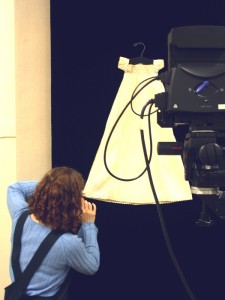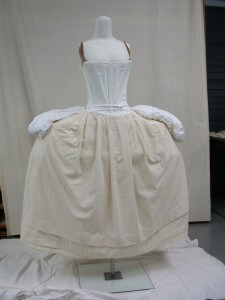I hear the occasional grumble. Why is that photo of that object so bad? Why isn’t there an online database? Why are only selected objects online? Why can’t museums get their acts together?
I worked on a grant project for three years photographing a large chunk of a major art museum’s costume collection. In that time, we photographed 7,000 objects in three years. Pre-Columbian textile fragments. Black socks. Purses. White handkerchiefs. Samplers. Gloves. For four days a week, our team would set out each object for a dedicated photographer. She would photograph the works, while my partner and I would do condition surveys on the objects. Our average rate was 20-30 objects a day.
But dressing works on mannequins takes time. We only dressed 130 ensembles on mannequins – we could generally manage dressing three objects a day. This isn’t department store window dressing, but we weren’t preparing the object as if it was being displayed in the galleries for three months either.
First we would slide a pair of nylons over the mannequin, to act as foundation for padding to be built upon it. Measurements from the garment would guide any additional padding needed. Layers of polyester batting were then sandwiched and stitched in place between the first and a second layer of nylons. Then period appropriate undergarments are added. This isn’t the same as dressing reenactors in fully authentic garb – the point is to create a proper shape for the historic garment without stressing it. In a pinch, some rolled Photo Tex tissue pinned to the dressing undergarments can make a pretty good bum roll. When you consider that photography of three dressed mannequins takes one day of a conservator’s time, one day of a collections care specialist’s (that would be me) time, and one day of a photographer’s time, the money starts to add up. This is without any conservation time to remove wrinkles; we didn’t photograph those things that needed serious treatment before dressing. In person hours alone, the photography of 3 mannequins cost between $600-1000. Most museums need grant or private funding to accomplish such projects.

A method for photographing baby dresses. The hanger is removed post-production. The corners of the gown were pinned to a fabric covered ethafoam slant board with insect pins.
Documenting collections through photography is one of those collection care tasks that goes unseen by the public. At this week’s American Institute for Conservation‘s conference “Connecting to Conservation: Outreach and Advocacy” there were several great presentations on educating visitors about collection care. Museums neglect to track costs of much collection care that is not attached to grants. But museums should make all conservation and collection care tasks more visible through their websites, gallery talks while collection care is taking place, and other outreach activities. If museum patrons don’t know our needs, how can they know we need funding?


As I assume you know, Winterthur’s exhibit of the Embroiderd Jacket had a lot of the costs paid for in small donations by a LOT of embroiders, and got a whole slew of new storage boxes paid for the same way, when the Thistle Threads blog asked us to…I know that we could get knitters to do the same for better knitted artifacts photos, if it got set up, and the word posted in the right places, if only The Yarn Harlot were interested in knitting history and asked….there would be a lot of donations, quickly (she got thousands to donate to Doctors Without Borders…she’s up around a million dollars, now)
Hi Colleen, excellent example of how to “microfund” these projects – but some museums aren’t aware or open to the benefit of this sort of fundraising. It’s interesting that even big museums with development offices often miss (or have no interest) these smaller grassroots lenders. Sometimes it seems that museums consider this their “dirty laundry” or not the exciting part of what they do – but most visitors I speak to are really interested, and it helps them connect to the museum and collections. Collection care should be on display, rather than hidden in the back room. A great document on this is Heritage Preservation’s Capitalize on Collections Care at http://www.heritagepreservation.org/PDFS/COClo.pdf.